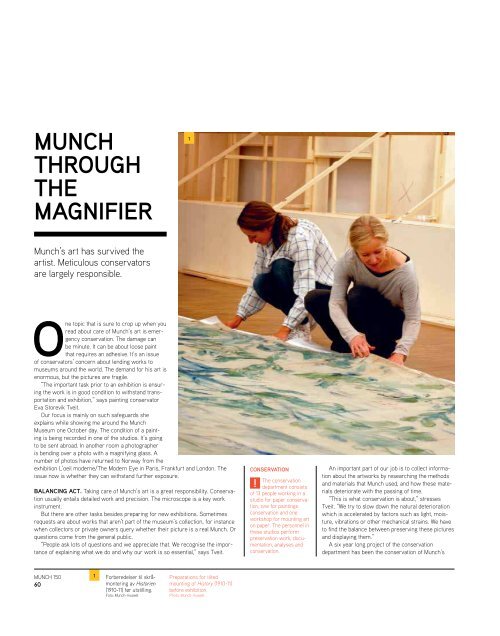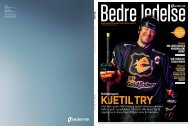Ferdig%20magasin
Ferdig%20magasin
Ferdig%20magasin
Create successful ePaper yourself
Turn your PDF publications into a flip-book with our unique Google optimized e-Paper software.
muncH<br />
tHrOuGH<br />
tHe<br />
maGnifier<br />
Munch’s art has survived the<br />
artist. Meticulous conservators<br />
are largely responsible.<br />
One topic that is sure to crop up when you<br />
read about care of Munch’s art is emergency<br />
conservation. The damage can<br />
be minute. It can be about loose paint<br />
that requires an adhesive. It’s an issue<br />
of conservators’ concern about lending works to<br />
museums around the world. The demand for his art is<br />
enormous, but the pictures are fragile.<br />
“The important task prior to an exhibition is ensuring<br />
the work is in good condition to withstand transportation<br />
and exhibition,” says painting conservator<br />
Eva Storevik Tveit.<br />
Our focus is mainly on such safeguards she<br />
explains while showing me around the Munch<br />
Museum one October day. The condition of a painting<br />
is being recorded in one of the studios. It’s going<br />
to be sent abroad. In another room a photographer<br />
is bending over a photo with a magnifying glass. A<br />
number of photos have returned to Norway from the<br />
exhibition L’oeil moderne/The Modern Eye in Paris, Frankfurt and London. The<br />
issue now is whether they can withstand further exposure.<br />
balancinG act. Taking care of Munch’s art is a great responsibility. Conservation<br />
usually entails detailed work and precision. The microscope is a key work<br />
instrument.<br />
But there are other tasks besides preparing for new exhibitions. Sometimes<br />
requests are about works that aren’t part of the museum’s collection, for instance<br />
when collectors or private owners query whether their picture is a real Munch. Or<br />
questions come from the general public.<br />
“People ask lots of questions and we appreciate that. We recognise the importance<br />
of explaining what we do and why our work is so essential,” says Tveit.<br />
MuNCH 150<br />
60<br />
1<br />
Forberedelser til skråmontering<br />
av Historien<br />
(1910-11) før utstilling.<br />
Foto: Munch-museet<br />
1<br />
Preparations for tilted<br />
mounting of History (1910-11)<br />
before exhibition.<br />
Photo: Munch-museet<br />
cOnserVatiOn<br />
The conservation<br />
department consists<br />
of 13 people working in a<br />
studio for paper conservation,<br />
one for paintings<br />
conservation and one<br />
workshop for mounting art<br />
on paper. The personnel in<br />
these studios perform<br />
preservation work, documentation,<br />
analyses and<br />
conservation.<br />
An important part of our job is to collect information<br />
about the artworks by researching the methods<br />
and materials that Munch used, and how these materials<br />
deteriorate with the passing of time.<br />
“This is what conservation is about,” stresses<br />
Tveit. “We try to slow down the natural deterioration<br />
which is accelerated by factors such as light, moisture,<br />
vibrations or other mechanical strains. We have<br />
to find the balance between preserving these pictures<br />
and displaying them.”<br />
A six year long project of the conservation<br />
department has been the conservation of Munch’s<br />
monumental sketches, among them his drafts for the<br />
university Aula decorations. They had been rolled<br />
up since Munch painted them and many were in<br />
very poor condition. These paintings have now been<br />
treated and are being stored properly.<br />
nOt self-eVident. What’s it like working in a<br />
museum where you get so close to one particular artist?<br />
“First let me point out that we don’t just represent<br />
one artist, but also the comprehensive collection<br />
of the Stenersen Museum. When dealing with the<br />
Munch collection you’re often encountering the same<br />
phenomena regarding the condition of the works,<br />
the materials and the problems. Our conservation<br />
efforts with these are more repetetive than in a<br />
museum with a more diverse collection. But on the<br />
other hand, we have the opportunity to delve into<br />
the techniques of a single artist. We develop a unique<br />
competence for these kind of paintings and become<br />
specialists, not just in<br />
conservation but also<br />
in Munch.”<br />
1<br />
Tveit doesn’t<br />
deny that the Munch<br />
Museum has been<br />
subjected to repeating<br />
media focus in the past<br />
few years. But there<br />
are exciting moments<br />
in the daily work of a<br />
conservator.<br />
“For instance we<br />
were really eager<br />
every time we unrolled<br />
a new monumental<br />
sketch. We were<br />
primarily concerned<br />
with the condition, but<br />
we were often surprised<br />
by the methods<br />
Munch used in these<br />
works. We were well<br />
acquainted with his<br />
motifs, but he often<br />
varied his techniques. Some paintings have a watercolour<br />
like appearance.<br />
She says the work carried out in her department is<br />
essential for preserving Munch’s paintings for future<br />
generations. A common complaint in the cultural sector<br />
is the struggle for sufficient time and funding.<br />
“We feel a lot of pressure to lend this art and we<br />
have to make priorities. Our challenge is to find time<br />
for more basic but totally essential tasks, the care of<br />
artworks that are less frequently exhibited. Our goal<br />
is to keep this art accessible for many future generations,”<br />
says Tveit.<br />
1<br />
Edvard Munch,<br />
Melankoli III, 1902.<br />
Munch-museet.<br />
Edvard Munch,<br />
Melancholy III, 1902.<br />
Munch Museum.<br />
2<br />
faVOrittbilete<br />
– Eg er veldig glad i grafikken til Munch, og tykkjer<br />
det er synd at ein ikkje oftare viser fram desse<br />
arbeida. Munch laga det same motivet i utallige<br />
variasjonar, med ulike fargar og strekar. Uttrykksforma<br />
hans, særleg i den mest ekspressive perioden,<br />
høver godt til den grafiske forma. Kanskje sidan<br />
fargane er mindre viktige, og streken er den som<br />
vert berar av det ekspressive.<br />
faVOurite picture<br />
“I truly appreciate Munch’s graphic works and I<br />
regret that we don’t exhibit them more often. Munch<br />
would repeat a subject matter countless times in different<br />
versions with change in colour and lines. His<br />
idiom, especially during the most expressive period,<br />
is well suited to the graphic technique. Perhaps it’s<br />
because colour is less important and the lines are the<br />
expressive component .”<br />
Edvard Munchs<br />
Pubertet, 1894,<br />
undersøkes av<br />
Eu-Autech MoLab<br />
Edvard Munchs Puberty,<br />
1894, is being examined<br />
by Eu-Autech MoLab<br />
2<br />
Omfattande arbeid<br />
Behovet for konservering er stort. Av 1158 maleri<br />
treng 904 konservering.<br />
Dei siste åra er det utført eit grundig forskingsarbeid<br />
og behandling av Pubertet, Madonna og<br />
Skrik.<br />
Det er utarbeidd konserveringsplanar for både<br />
Stenersen- og Munch-museet sine maleri med<br />
tidsberekning for kor mykje arbeid som må gjerast.<br />
Sidan 2010 har det vore konservering på Munch<br />
sine maleri i samband med at Munch-museet med<br />
Stenersenmuseets samlingar legg planar for flytting<br />
til eit nytt og moderne museumsbygg. Det er<br />
ynskjeleg å gjera ein tilsvarande gjennomgang av<br />
andre prioriterte deler av papirsamlinga.<br />
extensiVe WOrk<br />
There is a great demand for conservation. Among<br />
1,158 paintings, 904 are in need of conservation.<br />
In recent years the conservation department has<br />
performed comprehensive research and conservation<br />
on Puberty, Madonna and The Scream.<br />
Conservation plans have been completed for the<br />
Stenersen- and the Munch Museum’s paintings,<br />
including estimates of how much time each artwork<br />
requires.<br />
The Munch Museum’s collection includes 3,364<br />
drawings and 16,643 graphic works in addition to<br />
other paper material such as Munch’s sketchbooks<br />
and notebooks. The collection of drawings has been<br />
examined to prepare the works for a prospective<br />
move. Such efforts are also needed for other parts of<br />
the paper collection.<br />
Conservation work has been done on Munch’s<br />
paintings since 2010 in keeping with plans to move the<br />
Munch Museum’s and the Stenersen Museum’s collections<br />
to a new, modern building.<br />
MuNCH 150<br />
61




